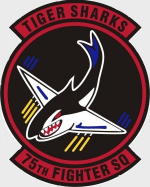Hobby Master HA1311 USAF Fairchild Republic A-10A Thunderbolt II Ground Attack Aircraft - "Killer Chick", 75th Fighter Squadron "Tiger Sharks", Operation Iraqi Freedom, Iraq, April 7th, 2003 (1:72 Scale)
"Obsolete weapons do not deter."
- British Prime Minister Margaret Thatcher
 The A-10 and OA-10 Thunderbolt IIs are the first Air Force aircraft designed specifically for close air support of ground forces. They are simple, effective, and highly survivable twin-engine jet aircraft that can be used against all ground targets, especially tanks and other armored vehicles. The first production A-10A was delivered to Davis-Monthan Air Force Base, AZ., in October 1975.
The A-10 and OA-10 Thunderbolt IIs are the first Air Force aircraft designed specifically for close air support of ground forces. They are simple, effective, and highly survivable twin-engine jet aircraft that can be used against all ground targets, especially tanks and other armored vehicles. The first production A-10A was delivered to Davis-Monthan Air Force Base, AZ., in October 1975.
The aircraft can carry a wide variety of ordnance under its wings and nose, loiter on-station for long periods of time, and fly over a wide combat radius, making it an ideal warrior on today's battlefield. In the Gulf War, A-10s, with a mission capable rate of 95.7 percent, flew 8,100 sorties and launched 90 percent of the AGM-65 Maverick missiles used in-country.
In 2005, the entire fleet of 356 A-10 and OA-10 aircraft began receiving the Precision Engagement upgrades including an improved fire control system (FCS), electronic countermeasures (ECM), and smart bomb targeting. The aircraft receiving this upgrade were redesignated A-10C. The Government Accounting Office in 2007 estimated the cost of upgrading, refurbishing, and service life extension plans for the A-10 force to total $2.25 billion through 2013. In July 2010, the USAF issued Raytheon a contract to integrate a Helmet Mounted Integrated Targeting (HMIT) system into the A-10C. The Air Force Material Command's Ogden Air Logistics Center at Hill AFB, Utah completed work on its 100th A-10 precision engagement upgrade in January 2008. The final aircraft was upgraded to A-10C configuration in June 2011. The aircraft also received all-weather combat capability, and a Hand-on-Throttle-and-Stick configuration mixing the F-16's flight stick with the F-15's throttle. Other changes included two multifunction displays, a modern communications suite including a Link-16 radio and SATCOM. The LASTE system was replaced with the integrated flight and fire control computer (IFFCC) included in the PE upgrade.
Throughout its life, the platform's software has been upgraded several times, and although these upgrades were due to be stopped as part of plans to retire the A-10 in February 2014, Secretary of the Air Force Deborah Lee James ordered that the latest upgrade, designated Suite 8, continue in response to Congressional pressure. Suite 8 software includes IFF Mode 5, which modernizes the ability to identify the A-10 to friendly units. Additionally, the Pave Penny pods and pylons are being removed as their receive-only capability has been replaced by the AN/AAQ-28(V)4 LITENING AT targeting pods or Sniper XR targeting pod, which both have laser designators and laser rangefinders.
In 2012, Air Combat Command requested the testing of a 600-US-gallon (2,300 l; 500 imp gal) external fuel tank which would extend the A-10's loitering time by 45-60 minutes; flight testing of such a tank had been conducted in 1997 but did not involve combat evaluation. Over 30 flight tests were conducted by the 40th Flight Test Squadron to gather data on the aircraft's handling characteristics and performance across different load configurations. It was reported that the tank slightly reduced stability in the yaw axis, but there was no decrease in aircraft tracking performance.
This particular 1:72 scale replica of an A-10A Warthog ground attack aircraft was nicknamed "Killer Chick", and attached to the 75th Fighter Squadron, then participating in Operation Iraqi Freedom, on April 7th, 2003.
Sold Out!
Dimensions:
Wingspan: 8-3/4-inches
Length: 9-3/4-inches
Release Date: February 2010
 Historical Account: "Tiger Sharks" - On May 18th, 1972, the squadron was redesignated the 75th Tactical Fighter Squadron, and on July 1st, 1972 was activated at England Air Force Base, Louisiana. There the squadron began flying the A-7D "Corsair II" aircraft. The unit has remained at England Air Force Base since then, flying the A-7D until 1981 when conversion to the A-10 "Thunderbolt II" was completed.
Historical Account: "Tiger Sharks" - On May 18th, 1972, the squadron was redesignated the 75th Tactical Fighter Squadron, and on July 1st, 1972 was activated at England Air Force Base, Louisiana. There the squadron began flying the A-7D "Corsair II" aircraft. The unit has remained at England Air Force Base since then, flying the A-7D until 1981 when conversion to the A-10 "Thunderbolt II" was completed.
On November 18th, 1991, the 75th Tactical Fighter Squadron deactivated at England Air Force Base. On April 3rd, 1992, the squadron was again activated, this time under the "Flying Tiger" flag as the 75th Fighter Squadron located at Pope Air Force Base, North Carolina.


